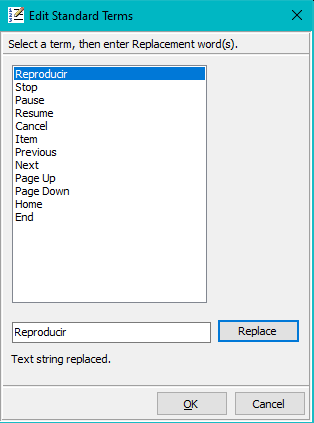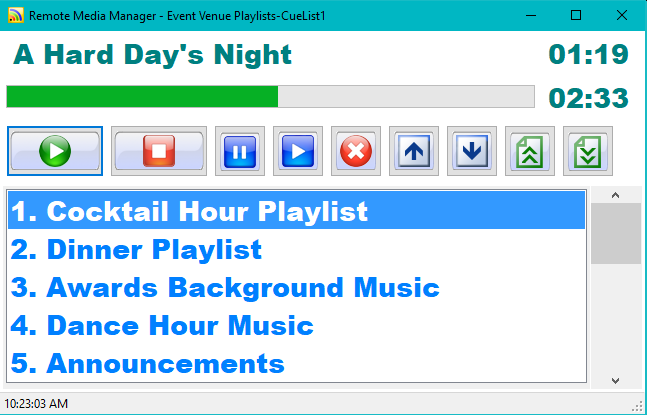
Program Menus
File
RMM uses Cue-List files (.XML file extension) exported from Sound Mill and Video Mill (export is under the IPC menu). The Cue-List files contain information about the items in the Soundlist and Medialist.
Menu items
- New Cuelist - Creates a new, empty Cuelist. If the current Cuelist has unsaved changes, you are prompted to save the changes first.
- File Open - Opens a Cuelist file. You can also open a Cuelist by double clicking on the filename in Windows Explorer.
- Save - The current Cuelist is saved to file. You only need to save the Cuelist if you have made edit changes to any Cues.
- Save As - Same as Save but a File Save dialog is popped up to save as a different file name.
- Recent Files - Shows a list of the 10 most recently opened files. Click on one to Open it.
- Clear Recent Files List - Clear all files from the Recent Files List.
- Exit - Closes the program. Stops IPC, and closes any open communications ports.
File Open by Drag/Drop
You can open a Cuelist file by Drag/Drop from any file manager (ex. Windows File Explorer).

File toolbar
- File toolbar - Buttons (from left to right): New Cuelist, Cuelist File Open, Save Cuelist, View Cuelist Details, and program Options.

Edit Cuelist
See separate Cuelist Management page.
View
Menu items
- Clicking these menu items toggles (Show/Hide) the view state of the related program control.
- Play Control Buttons Panel - This is the panel of large Play action buttons.
- Menu bar - Toggles between show/hide of the Menu bar. (Ctrl+M).
- Hide Window Titlebar - Toggles between show/hide of the Window Titlebar. When hidden, the window cannot be resized with the mouse by dragging the side borders or the corner border grip. Useful for kiosk app.
-
Toolbars
- Show or Hide Toolbars - You are prompted to select which toolbars you want to Show or Hide.
- Reset Toolbars - Toolbars are reset to default positions and visibility. (Ctrl+Alt+R).
- Arrange Toolbars - Toolbars are reordered to default positions just under the menu bar.
- Refresh - Refreshes the UI after editing a CueList or changing Options that affect CueList visual presentation.
- Resize Play Buttons - Resizes the Play Buttons panel after changing the Play Buttons Size Scale Factor in the Options.
- Toggle Full Screen - This toggles the program window between Full Screen and Normal size. (Ctrl+F11)
- Suppress Status Messages - When checked, informational messages on the status bar (at bottom of the app window) are suppressed. May be desired for some kiosk usage. This may also suppress some logging.
Actions
The Actions menu items functions are the same as the Play Actions buttons listed on the Quick Start page.
Player
The Player menu items are listed on the Player page.
Voice
The Voice menu items are listed on the Voice Interface page.
Tools
Menu items
- Options - See separate Option section in the Table of Contents.
- IPC Inter-Process Comms - See separate IPC Help page.
-
Standard Terms - See details below.
- Edit - Change any of the Standard Terms. In the Standard Terms dialog, select a term, then enter the new word(s) into the text box and click the Replace button. (Figure 2)
- View - View the current Standard Terms.
- Reset to Program Defaults - Resets the Standard Terms to the program defaults (in English).
- Remote Tools - See Remote Tools Help page for details.
- Manage Favorite Colors - Configure and save colors for reuse.
- Manage Favorite Fonts - Configure and save fonts for reuse.
- Restore Options to Factory Default Settings - Restores all program default Options. Removes all client configurations and Cuelists. Use cautiously.
- Halt All on All Remote Clients - Halts all playing media on all remote clients. So if you are controlling both SoundMill and VideoMill, all media is stopped on both programs.
- Shortcut Key Summary - Lists all the program keyboard shortcuts.
Standard Terms
The Standard Terms are terms that are associated with the Play Control Actions buttons (Figure 3). Each term can be one word or a multiple word phrase. They are used for the Voice Interface and optionally for tooltips on the buttons. There are two reasons you may want to change these from the program defaults: 1) For national language translation of action names; 2) For a preferred word for one or more actions when using RMM as a kiosk.
When viewing the Standard Terms, the action associated with the term (Term Usage) is listed next to the Applied Word(s).
There are 12 Standard Terms: "Play", "Stop", "Pause", "Resume", "Cancel", "Item", "Previous", "Next", "Page Up", "Page Down" , "Home", "End". For example, if your language is set to Spanish, then change "Play" term to "Reproducir", etc (Figure 2). "Item" is interpreted by the voice engine as 'the selected Cue item'.

User Interface Lock (UI)
This allows you to lock/unlock the Admin features of the UI. When untrained/novice users are given access, you may want to hide adminstrative features from these users by locking the UI. When locked some menus are not available. You are prompted to enter the Admin password for authorization. The Admin password must be set in the Options to use the Lock feature.
Menu items
- Lock - Locks the Admin features of the UI. (Figure 3).
- Unlock - Unlocks the Admin features of the UI.
Help
- View Help - Opens the Contents page for the program Help document in your Web browser.
- Session Log - Opens the application log. If you encounter errors when running the program, detailed error messages may get posted to this log. The messages may be helpful in determining corrective actions. Copy and paste any related error messages to emails when communicating problems to Support. The log is a simple text file. You can delete messages from previous sessions if you only want to see today's messages.
- Web Site and Support - Opens the Support Web site page in your browser.
- Check for Updates - Will ping our Web site to get lastest version.release (V.r) level and compare to your program V.r. If a later V.r is available, you should go to the Web site to download and install it.
- Activate - The program must be activated to unlock full program function. A valid purchase order Transaction Id is your Activation code. Activation will attempt to connect to the our Website to validate your code. Your computer firewall may ask if the program is permitted to access the Web. You need to allow it to access the Web this one time. No private or personally identifiable information is transferred in this process. The activation is good only for the computer on which the program is activated. This program is licensed on a one machine per order number basis.
- Misplaced Password Removal - Allows Removal of program UI Lock password in the event you forget the password . You are prompted for your customer activation code to access this feature. Your customer activation code can always be retrieved via our Website Customer Self Service form.
- About - Program version and release information. Licence agreement and publisher Website link. When communicating problems to Support, please include this information in your email by copy and paste.

Limitations
- Clicking Play Twice When Running a Script - If you click Play a second time without first stopping the Script, the RMM progress bar may zero out and appear as if nothing is playing. If you click Scan for Playing Media on the Remote Tools toolbar it should restore the progress bar indicator. In any case, when the next item in the script begins playing, the progress bar will be updated.
- Running Concurrent Scripts - RMM will allow you to start concurrent scripts, however the RMM progress bar will change every time a media item starts playing in any script. In this case, the best way to determine status of a script is to select the RMM cue, then click the Get Remote Status on the Remote Tools toolbar.
 Page Bottom
Page Bottom To Page Top
To Page Top